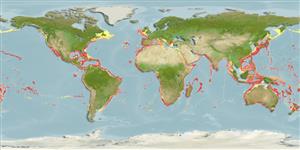Environment: milieu / climate zone / depth range / distribution range
экология
морской донно-пелагический; мигрирует в океане (Ref. 51243); пределы глубины 100 - 975 m (Ref. 9302), usually 200 - 400 m (Ref. 6181). Subtropical; 55°N - 43°S, 180°W - 180°E (Ref. 6181)
Circumtropical and temperate seas of the world.
Size / Вес / Возраст
Maturity: Lm ? range ? - ? cm
Max length : 300 cm TL самец/пол неопределен; (Ref. 5951); common length : 150 cm SL самец/пол неопределен; (Ref. 6181); наибольший вес (опубликованные данные): 63.5 kg (Ref. 4699)
колючие лучи спинного плавника (общее число) : 13 - 15; членистые (мягкие) лучи спинного плавника (общее число) : 15 - 18; колючие лучи анального плавника: 0; членистые (мягкие) лучи анального плавника: 15 - 18; позвонки: 32. Skin very rough, scales interspersed with spinous bony tubercles. Mid-ventral (abdominal) keel on the ventral contour. Body is uniformly brown to dark brown, tips of the pectoral and pelvic fins black, margins of the second dorsal and anal fins white in young specimens.
Usually over the continental shelf, sometimes in oceanic waters down to 800 m (Ref. 9302). Usually solitary or in pairs near the bottom (Ref. 6181). Migrates far offshore (Ref. 26139). Pelagic (Ref. 5951). Feeds on fish, crustaceans and squid (Ref. 6181). The peculiar wooden 'palu' or Ruvettus hook is used to catch this species in south central Pacific (Ref. 6181). The flesh is very oily, with purgative properties, if eaten much (Ref. 6181). Marketed fresh and as fish cakes in Japan (Ref. 9302); also processed into fishmeal (Ref. 5217). Maximum length reported to reach up to 2 m only (Heemstra, pers. comm. 03/03).
Life cycle and mating behavior
Maturities | размножение | Spawnings | Egg(s) | Fecundities | личинки
Nakamura, I. and N.V. Parin, 1993. FAO Species Catalogue. Vol. 15. Snake mackerels and cutlassfishes of the world (families Gempylidae and Trichiuridae). An annotated and illustrated catalogue of the snake mackerels, snoeks, escolars, gemfishes, sackfishes, domine, oilfish, cutlassfishes,. scabbardfishes, hairtails, and frostfishes known to date. FAO Fish. Synop. 125(15):136 p. (Ref. 6181)
Статус Красного Списка МСОП (Ref. 130435)
Угроза для людей
Poisonous to eat (Ref. 4690)
Использование человеком
рыболовство: не имеет хозяйственного значения; объект спортивного рыболовства: да
дополнительная информация
инструменты
Специальные отчеты
Скачать в формате XML
ресурсы в Интернет
Estimates based on models
Preferred temperature (Ref.
123201): 8.6 - 19, mean 12.9 °C (based on 603 cells).
Phylogenetic diversity index (Ref.
82804): PD
50 = 1.0000 [Uniqueness, from 0.5 = low to 2.0 = high].
Bayesian length-weight: a=0.00347 (0.00191 - 0.00629), b=3.10 (2.93 - 3.27), in cm total length, based on LWR estimates for this species & (Sub)family-body (Ref.
93245).
Trophic level (Ref.
69278): 4.2 ±0.57 se; based on food items.
устойчивость к внешним воздействиям (Ref.
120179): низкий, минимальное время удвоения популяции 4.5-14 лет (Assuming tm>4).
Prior r = 0.28, 95% CL = 0.19 - 0.42, Based on 1 data-limited stock assessment.
Fishing Vulnerability (Ref.
59153): Very high vulnerability (90 of 100).
Climate Vulnerability (Ref.
125649): Moderate vulnerability (38 of 100).
Nutrients (Ref.
124155): Calcium = 17.3 [7.8, 32.2] mg/100g; Iron = 0.573 [0.271, 1.108] mg/100g; Protein = 17.7 [15.5, 19.7] %; Omega3 = 0.202 [0.110, 0.353] g/100g; Selenium = 81.8 [36.6, 171.9] μg/100g; VitaminA = 10.3 [3.2, 36.7] μg/100g; Zinc = 0.411 [0.288, 0.611] mg/100g (wet weight);
